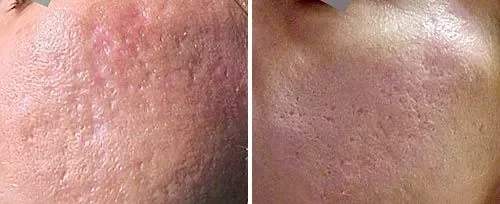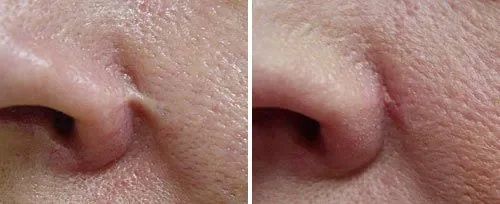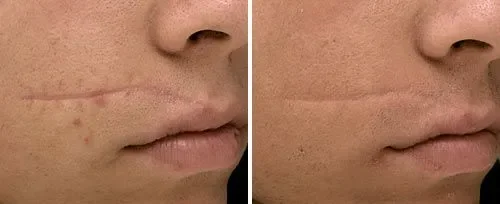
Laser Scar Treatments in Toronto
Reduce The Appearance Of Your Scars With Advanced Laser Scar Revision Therapy.
Proven Results
At Emerald Skin Labs, we offer advanced laser scar-revision treatments that utilize cutting-edge technology to effectively reduce the appearance of scars and improve skin texture. Our scar removal laser treatment is ideal for minimizing scars resulting from acne, injuries, or surgeries.
After
Before
Treatment & Technology
Fotona's pioneering dual-wavelength scar-revision therapy combines the power of two distinct laser wavelengths:
Er:YAG Laser: This wavelength is ideally suited for gentle ablation of scar tissue and activating collagen remodelling. It is particularly effective for improving the appearance of acne scars by precisely targeting and resurfacing the affected skin.
Nd:YAG Laser: For tougher scars, such as hypertrophic scars, the Nd:YAG wavelength deeply penetrates the skin. Clinical research shows significant improvement in the aesthetic appearance, volume, and pliability of these scars, including the reduction of redness (erythema).
Fotona fractional laser skin resurfacing effectively treats various scars, including:
Acne Scars
Surgical Scars
Hypertrophic Scars
Keloid Scars
This synergistic dual-wavelength solution offers quick visible results that surpass traditional scar treatment techniques, all without damaging the skin surface. It not only addresses the scar's aesthetic appearance but also helps to resolve complicating factors with the scar’s vascular feeding system, promoting comprehensive healing and a more natural look. Schedule a consultation with us to discuss your scar treatment options!
Proven Results for All Skin Tones
Take Advantage of This Treatment With Us
Treatable Areas
Laser scar revision is a safe and effective method for improving the appearance of scars on various parts of the body. Scars can develop anywhere, and this treatment can help even out the texture and hyperpigmentation, promoting a more even area.
What to Expect
-
To determine if Fotona laser scar revision is right for you, a personalized assessment is crucial. Our skilled professionals will evaluate your scar type, skin condition, and aesthetic goals to create a tailored treatment plan. Whether you want to minimize acne scars, surgical scars, or improve skin texture and radiance, we’ll guide you through the process to achieve optimal results.
-
Before your Fotona laser scar revision treatment, your specialist will review the details with you and answer any questions to ensure you're informed and comfortable. After obtaining your consent, we'll take photos to document your starting point and track your progress throughout the treatment.
-
To prepare for your Fotona laser scar revision at our Toronto clinic:
Avoid Sun Exposure: Limit direct sun and tanning (including self-tanners) for at least two weeks before treatment to reduce complications.
Discontinue Irritants: Pause using irritants like retinoids, AHAs, BHAs, and other exfoliants 5-7 days prior to your appointment to minimize skin sensitivity. -
The Fotona laser scar revision is a quick, non-invasive procedure lasting 30 to 60 minutes, causing mild discomfort and no downtime. For optimal results, 3-6 sessions are typically recommended, spaced 4-6 weeks apart. Deeper scars may necessitate more treatments.
You may feel an immediate sense of tightness, with full benefits appearing gradually over 2 to 3 months, and continued improvement for up to six months as your skin heals.
Follow-Up and Maintenance
Sun Protection: Avoid sun exposure for 1-2 weeks. Use SPF 30+ sunscreen.
Gentle Care: Use mild cleanser, hydrating moisturizer, and use non-comedogenic products. Avoid scrubs, retinoids, acids (AHA/BHA), vitamin C, or other active skincare products. Avoid picking or scratching peeling skin. Avoid makeup for 48 hours.
Rest: Avoid sweating, heat or strenuous activities for 48 hours. No swimming for 48–72 hours post-treatment.
Follow-Up: Results may take several days to weeks to appear; multiple sessions are often required for optimal results.
Contraindications
Pregnant or Breastfeeding Women: Treatment should be postponed during pregnancy or breastfeeding. Extra caution is advised for individuals with very sensitive skin or darker skin tones (Types V and VI).
See if this treatment is right for you.
Online Store
FAQs
-
Ablative Laser Resurfacing (CO2, Er:YAG) results can last 3-5 years or more, with maintenance required to preserve the results.
Non-Ablative Laser Resurfacing (Fractional CO2, Fractional Er:YAG, Nd:YAG) results typically last 1-3 years, but require ongoing treatments for sustained improvement.
Sun protection, a healthy lifestyle, and good skincare are crucial to maintaining the effects of the procedure for as long as possible.
-
Yes, laser resurfacing can be highly beneficial for improving the texture, tone, and appearance of your skin, especially for those dealing with wrinkles, scarring, sun damage, or uneven skin tone. The treatment stimulates collagen production, leading to firmer, smoother, and more youthful-looking skin.
-
Laser resurfacing is suitable for a wide range of people, particularly those who want to address common skin issues such as:
Fine lines and wrinkles.
Sun damage (e.g., sun spots, age spots).
Uneven skin tone (e.g., redness, pigmentation issues).
Acne scars or textural scars.
Enlarged pores.
-
Ablative lasers (CO2, Er:YAG) are more painful due to the deeper skin resurfacing they perform. While numbing agents and sedatives help manage discomfort during the treatment, post-treatment pain can range from moderate to severe in the days following the procedure.
Non-ablative lasers (Fractional CO2, Nd:YAG) are much less painful and generally have mild discomfort during and after the treatment.
The overall pain experienced can vary based on individual pain tolerance and treatment intensity, but the procedure is generally well-tolerated with proper preparation, pain management, and aftercare.
Pain Management During the Procedure:
To minimize discomfort during the procedure, the following techniques are typically used:
Topical Numbing Cream: Applied to the skin about 30 minutes before treatment to numb the area and reduce pain.
Local Anesthesia: For more invasive procedures, particularly ablative lasers, a local anesthetic (usually an injection) may be used to completely numb the treatment area.
Sedation: For highly sensitive individuals or aggressive treatments, some patients opt for oral sedatives or a mild IV sedative to relax and numb the body further.









